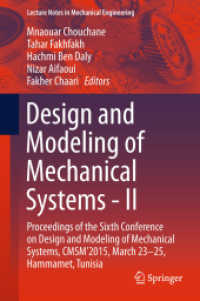- ホーム
- > 洋書
- > 英文書
- > Science / Mathematics
Full Description
Marcel Grossmann Meetings are formed to further the development of General Relativity by promoting theoretical understanding in the fields of physics, mathematics, astronomy and astrophysics and to direct future technological, observational, and experimental efforts. In these meetings are discussed recent developments in classical and quantum gravity, general relativity and relativistic astrophysics, with major emphasis on mathematical foundations and physical predictions, with the main objective of gathering scientists from diverse backgrounds for deepening the understanding of spacetime structure and reviewing the status of test-experiments for Einstein's theory of gravitation. The range of topics is broad, going from the more abstract classical theory, quantum gravity and strings, to the more concrete relativistic astrophysics observations and modeling.The three volumes of the proceedings of MG12 give a broad view of all aspects of gravitational physics and astrophysics, from mathematical issues to recent observations and experiments. The scientific program of the meeting includes 29 plenary talks stretched over 6 mornings, and 74 parallel sessions over 5 afternoons. Volume A contains plenary and review talks ranging from the mathematical foundations of classical and quantum gravitational theories including recent developments in string theories, to precision tests of general relativity including progress towards the detection of gravitational waves, to relativistic astrophysics including such topics as gamma ray bursts, black hole physics both in our galaxy, in active galactic nuclei and in other galaxies, neutron stars, pulsar astrophysics, gravitational lensing effects, neutrino physics and ultra high energy cosmic rays. The rest of the volumes include parallel sessions on dark matter, neutrinos, X-ray sources, astrophysical black holes, neutron stars, binary systems, radiative transfer, accretion disks, alternative gravitational theories, perturbations of collapsed objects, analog models, black hole thermodynamics, cosmic background radiation & observational cosmology, numerical relativity & algebraic computing, gravitational lensing, variable ';constants'; of nature, large scale structure, topology of the universe, brane-world cosmology, early universe models & cosmic microwave background anisotropies, inhomogeneous cosmology, inflation, gamma ray burst modeling, supernovas, global structure, singularities, cosmic censorship, chaos, Einstein-Maxwell systems, inertial forces, gravitomagnetism, wormholes & time machines, exact solutions of Einstein's equations, gravitational waves, gravitational wave detectors & data analysis, precision gravitational measurements, history of relativity, quantum gravity & loop quantum gravity, Casimir effect, quantum cosmology, strings & branes, self-gravitating systems, gamma ray astronomy, cosmic rays, gamma ray bursts and quasars.
Contents
Geometry From the Spectral Point of View, the Spectral Model of Space-Time (Alain Connes); The Formation of Black Holes by the Focusing of Incoming Gravitational Waves (Demetrios Christodoulou); On the Minimum Size of Astrophysical Compact Objects (Hernando Quevedo); Black Holes as a Source of Information (Juan Maldacena); Black Hole Entropy in the Extremal Limit (Ashoke Sen); Transplanckian String Collisions: An Update (Gabriele Veneziano); Ultraviolet Divergences and Scale-Dependent Coupling in Quantum Gravity (Herbert Hamber); Black Holes and Linear Waves (Igor Rodnianski); The Emerging Global Network of Gravitational Wave Detectors: LIGO and Virgo Open a New Window to the Universe (David Reitze); "Analytical Relativity" of Black Holes (Thibault Damour); Detection of Gravitational Waves with Pulsar Timing (Dick Manchester); Relativistic Spin-Precession in Binary Pulsars (Michael Kramer); Ground-Based Observations of Gamma-Ray Bursts: Latest Highlights from Large and Robotic Telescopes (Massimo Della Valle); Gamma-Ray Bursts in the Swift/Fermi Era (Tsvi Piran); Fundamental Physics from Black Holes, Neutron Stars and Gamma-Ray Bursts (Remo Ruffini); The Fascinating TeV Sky (Felix Aharonian); Galaxy Clusters and Their Central Supermassive Black Holes (Eugene Churazov); Intergalactic Shock Fronts (Maxim Markevich); Studying Dark Energy by Counting Galaxy Clusters (Alexey Vikhlinin); Weak Gravitational Lensing and Cosmology (Yannick Mellier); and other papers.








